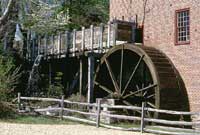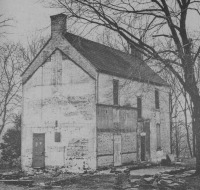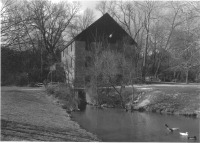|
 Photo: Copyright � 1982 by David T. Gilbert. Colvin Run Mill Park and Village
To hikers on the Difficult Run Trail, it sometimes seems as if all roads lead
Colvin (Carper's) Mill, now part of Colvin Run Mill Park, operated as a mill by Fairfax County Park Authority. With the intention of building a mill,
Colvin Run Village, or Leigh Corners, a half-mile up Colvin Run Road from the trail, features the Alfred Leigh house (1890), now a restaurant; Colvin Run School; a grange; and a working country store. Long before Tyson's Corner became an "edge city," Colvin Run Village was the largest settlement on Leesburg Pike between Falls Church and Leesburg:
The decade of 1910-1920 was the last one in which the village was a well-defined community. Once the roads were paved, the automobile provided a way to obtain services elsewhere. In 1941, Virginia relocated Route 7, bypassing the village. It fell into a slumber until Great Falls became a suburb of Washington. The relocation of Route 7 also reduced the capacity of the mill pond. The owner of the mill filed suit against the state, in which he was eventually successful. History is about to repeat itself, because the Virginia Department of Transportation wants to widen Route 7 from two-lanes to three-lanes in each direction. One glance at the highway's proximity to the mill pond suggest that Colvin Run Mill park may suffer again. See this site's interesting places on the Difficult Run Trail for more information.
Related Sites The best site on Colvin Run Mill. |
|
Watch for the work on the flume and the waterwheel, mid-February
And watch for the new oak turn shaft, to be delivered in March (originally January)! The Virginia Department of Forestry donated the trunk of a white oak which was about 125 years old. The Washington Times ran an article on the harvesting of this tree on March 24, 2000.Colvin Run Mill was selected to be a "Heritage and History Site" of the Amercian Society of Mechanical Engineers.


